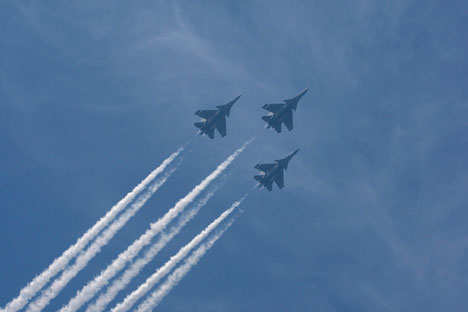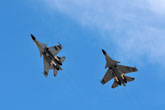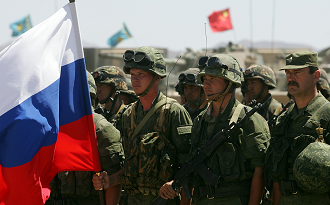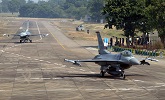Flanker fleet down, but not out

The Su-30MKI is the key element in India’s strike force. Source: AP
The cyber attack on Russian communication systems by anonymous hackers this month has raised concerns about the maintenance of the Su-30MKI, India’s air dominance fighter. According to the leaked correspondence between Hindustan Aeronautics Ltd (HAL), which assembles the Su-30MKI under licence in India and Russia’s United Aircraft Corporation (UAC), 50 percent of the Flankers are said to be unfit for operational flying. In comparison, the Indian Air Force’s MiG-29 fleet readiness rate is around 75 percent, which is on a par with US Air Force (USAF) levels.
In a letter dated February 28, 2014, Appasaheb Malagaudanavar, General Manager of HAL's Aircraft Upgrade R&D Centre, Nasik, writes: “Multiple cases of repeated failure of Mission Computer-1 and blanking out of head up displays (HUD) and all multi-function displays (MFD) in flight… As the display blanking off is a serious and critical issue affecting the exploitation of aircraft (it) needs corrective action/remedial measures on priority.”
An earlier letter from December 24, 2013 says due to non-availability of facilities for overhaul of aircraft parts, “the serviceability of Su-30MKI is slowly decreasing and demand for aircraft on ground items on the rise”.
Another letter written in December by HAL to Rosoboronexport, says, “The schedules of supplies and deputation of Russian specialists from original equipment makers, other than Irkut Corporation, has been repeatedly postponed by the Russian side and the progress in setting up of facilities has been far from the satisfaction of both HAL and IAF.”
It was agreed the Russian side would establish facilities at HAL by December 2013 and overhaul the first aircraft by June 2014. The letter says, the matter was discussed and agreed upon by Russia during various high level forums.
Blame game
Defense Industry Daily blames the problem on the lack of an ROH facility for the Flanker fleet: “One reason the MiG-29 fleet is doing better is that India has worked to build infrastructure like local RD-33 engine plants, bypassing the Russians entirely. Russian firms were supposed to set up an Su-30MKI ROH facility at HAL by December 2013, but that has fallen into a black hole, and so has the posting of aircraft specialists.”
“India itself is often at fault in these scenarios, and indeed they’re reportedly haggling over price,” it says.
While HAL has been prodding Sukhoi to expedite matters, the Indian company isn't entirely blameless when it comes to supplying spares it is contractually obligated to manufacture. In this case, the victim is the Algerian Air Force.
In a February 2014 letter Vyacheslav Lozan, After Sales Director at Sukhoi, reminds Sunil Kumar, General Manager, HAL, to stick to the contract to supply parts to the Algerian Air Force.
“Taking into account the fact the Algerian party insists on delivery of all the indicated equipment of HAL's manufacture, we have to admit it is impossible to exclude the indicated items from the contract,” he says.
HAL, however, does not deserve all the flak. In December 2012 it had floated a tender for “civil works extension of building for Su-30 ROH (repair and overhaul) project” at the company's plant in Korwa, Uttar Pradesh.
At the same time, Sukhoi cannot get around the clause in the support contract that states Russian specialists are to be posted even if price negotiations aren’t finalised. Considering India’s clout as the world’s largest arms importer, it is owed a good explanation.
Is the IAF in trouble?
Contrary to news reports, not right now. Says Defense Industry Daily: “India isn’t neglecting its high end Su-30s, though. Initial Su-30MK and MKI aircraft have all been upgraded to the full Su-30MKI Phase 3 standard, and the upgraded Super 30 standard aims to keep Sukhoi’s planes on top. Meanwhile, production continues, and India is becoming a regional resource for Su-27/30 Flanker family support.”
As of March 2013, the IAF had 194 Flankers and HAL’s production rate is 12 aircraft per year for an eventual total of 272.
While neither the Russian nor Indian side can duck the blame for the state of affairs, media reports that the Flanker fleet is in trouble are overly alarmist. Currently just 20 aircraft – the equivalent of a single squadron – are affected by the Russia-India standoff.
Assuming the 50 percent fleet readiness reports are true, will the IAF manage to fight a war with roughly 100 Flankers reporting for combat duty? The short answer: depends on the enemy.
The Pakistan Air Force (PAF) currently has 63 American made F-16s and 49 Chinese made JF-17s of doubtful quality. Against these numbers, not counting the Sukhois, the IAF has 59 MiG-29s, 49 Mirage 2000s, 254 MiG-21s, 79 MiG-27s and 117 Jaguars.
It’s a complete mismatch and when you factor in the much better quality of Indian pilots, there’s simply no contest.
The IAF is in an entirely different league. In the 1971 War it had established air superiority by the 10th day of fighting, and the PAF brass had ordered its pilots to stand down to avoid further crippling losses.
In the 1999 Kargil War because of the aerial superiority achieved by the IAF, the PAF’s “psyche took a big beating”, says a Strategy Page report. “Analyses by Pakistani experts revealed that when the rubber met the road, PAF simply refused to play any part in support of the Pakistan Army, angering the latter.”
In the 2012 report “Airpower at 18,000 feet: IAF in the Kargil War”, the Carnegie Endowment for International Peace says, when MiG-29s were providing top cover for IAF aircraft blasting Pakistan Army positions, the “PAF F-16s to the west typically maintained a safe distance of 10 to 20 miles on the Pakistani side of the LoC”.
It’s, therefore, abundantly clear that even without the Flankers joining the fight, the IAF is likely to grind down the PAF.
However, the equation is different if Islamabad and Beijing join hands. As the current air chief said recently, the IAF cannot take on a joint attack by the two. The Sukhoi thus becomes critical in a two-front war.
Meanwhile in the West
For comparison, the USAF’s most expensive aircraft, the super-secret B2A stealth bomber, has a fleet availability rate of just 46.7 per cent. That's dreadful for an aircraft costing $2.1 billion. The B-1B bomber fleet availability rate is 57.9 per cent and America's newest and most expensive fighter, the F-22 Raptor, despite its $350 million price tag has a fleet availability rate of 69 percent.
Plane dangerous
Malfunctioning of cockpit displays and mission computers is unusual in high-end aircraft. The Flanker is acknowledged to be superior to every combat jet except arguably the F-22. The IAF and Sukhoi need to figure out how this is happening especially when Malaysia and Indonesia, which fly a similar Flanker, haven’t experienced these glitches. Was it a malicious virus or just poor maintenance?
Also, India’s Defence Ministry, which has the agility of a sloth on tranquilisers, should not be allowed to get in the way of the IAF establishing a dedicated Flanker ROH facility. The Su-30MKI is the key element in India’s strike force; delay is not an option.
All rights reserved by Rossiyskaya Gazeta.
Subscribe
to our newsletter!
Get the week's best stories straight to your inbox



